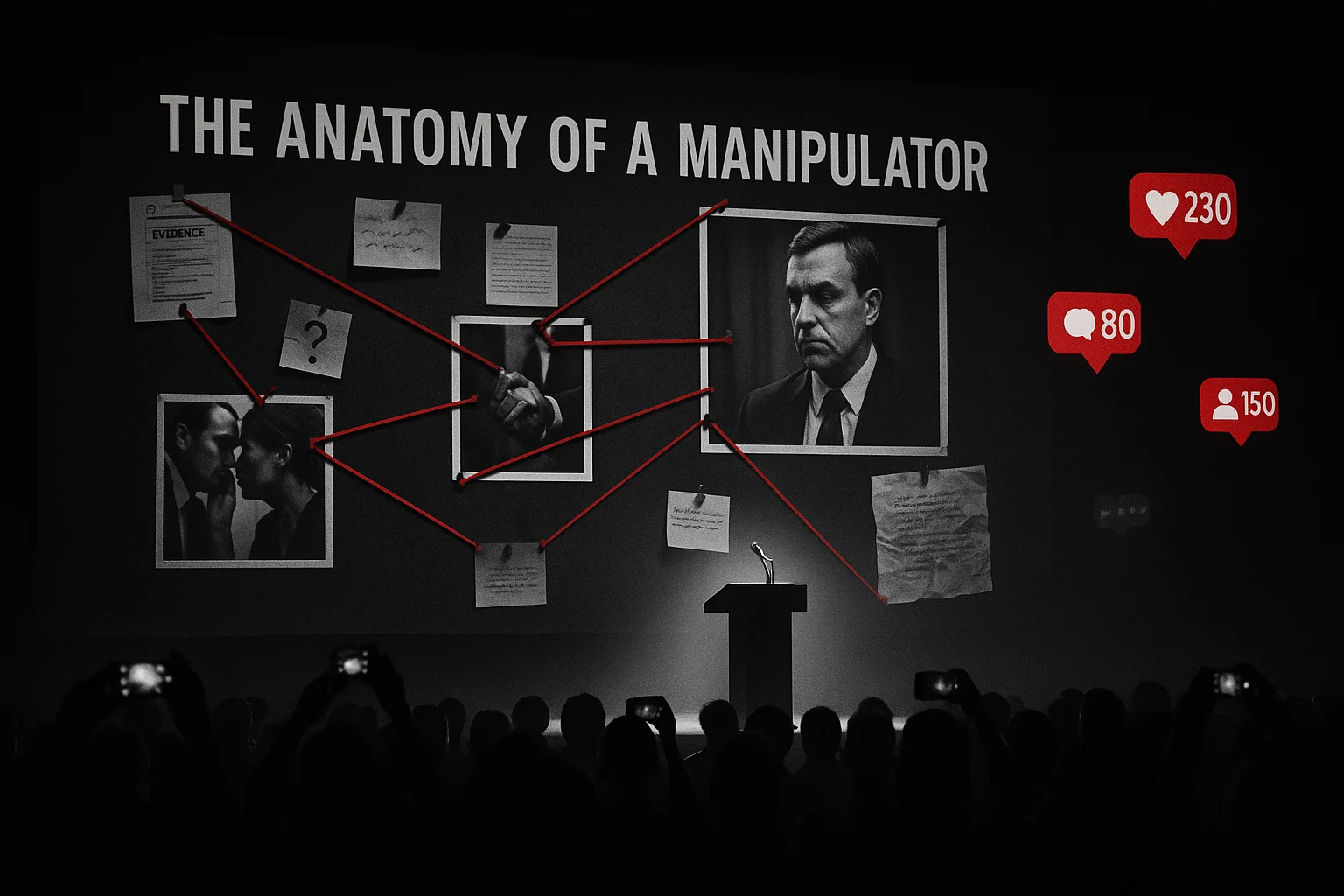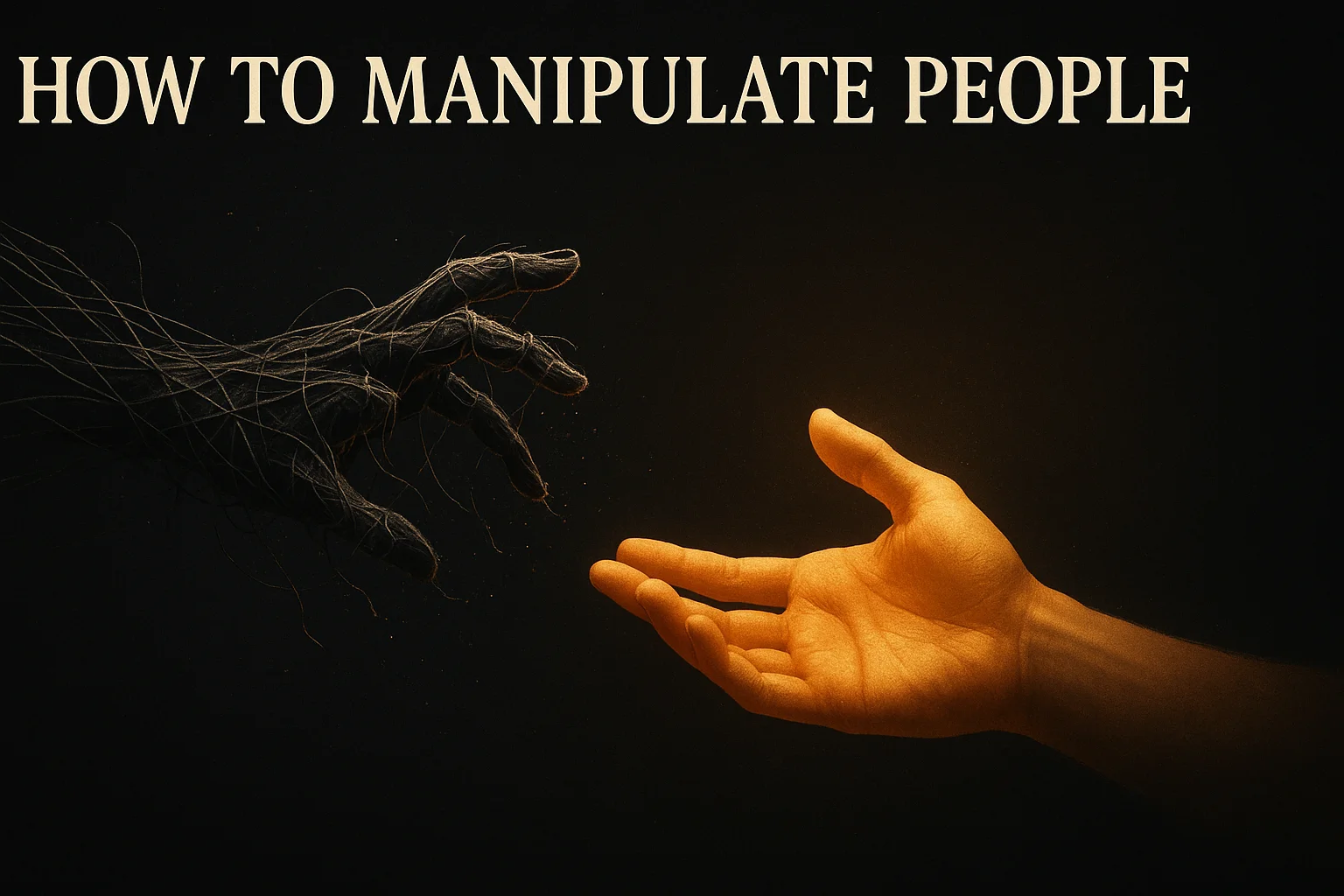How to Manipulate People: A Step by Step Guide
Kaikasi Chronicles: House of cards always Collapses
In the digital age, there lived a woman named Kaikasi who believed she had discovered the ultimate power—the ability to pull invisible strings that made others dance to her tune.

She had studied every manipulation technique, memorized every psychological trigger, and even delved into ancient witchcraft to enhance her power over others. She mixed occult rituals with modern psychology, believing that combining old and new forms of control would make her invincible. Friends, lovers, business partners, colleagues—all became marionettes in her grand performance.
Her mentor, an aging con artist who had found redemption, warned her: “Child, the strings you weave will one day become your noose. I spent decades perfecting these dark arts, only to discover they perfected my isolation.”
Kaikasi laughed. “You grew weak with age. I am different. Smarter. I have technology you never dreamed of.”
She was particularly proud of her hybrid arsenal. While others relied on charm alone, Kaikasi combined digital hacking with ancient practices—she tracked locations while casting subtle psychological “spells,” analyzed social media patterns alongside people’s superstitions. She knew her targets' fears, desires, and secrets before they even met, weaponizing both their digital footprints and their spiritual beliefs. Each interaction was choreographed, each word calculated for maximum impact.

For years, she seemed unstoppable. Promotions came easily—she always knew which executive’s insecurity to exploit. Relationships bent to her will—she could manufacture jealousy or devotion with surgical precision. Even strangers would find themselves inexplicably doing her bidding after brief encounters.
“I am a goddess of influence,” she would whisper to her reflection, intoxicated by her own perceived power.
But hubris has a way of documenting itself.
One target, a salesman named Marcus, seemed particularly easy to manipulate. Kaikasi deployed her full arsenal—hacking his devices, crafting personas that matched his interests, orchestrating “coincidental” meetings. She needed his access codes for a larger scheme.
He noticed the too-perfect coincidences, the way Kaikasi always knew things she shouldn’t, how her emotions seemed to shift like theater masks.
Intrigued and disturbed, Marcus did what he did best—he investigated and traced the digital breadcrumbs. Every hack she’d performed, every false account created, every keystroke logger installed—all had left traces she’d been too arrogant to properly hide.
Marcus didn’t just expose Kaikasi. He created a presentation—“The Anatomy of a Manipulator”—using her as a case study. The logs of her hacks, the patterns of her lies, the testimonies of her victims—all laid bare in devastating detail.

The presentation went viral.
Overnight, Kaikasi transformed from puppet master to punchline. Memes of her manipulation attempts spread across social media. Former victims came forward with their own stories. Law enforcement, now armed with evidence of her cyber crimes, came knocking.
In court, the prosecutor used her own techniques against her, and she found herself unable to counter them—everyone knew her playbook now. The judge, having reviewed years of her digital crimes, showed no mercy.
Old habits die hard. Even in prison, she tried her tricks—psychological manipulation, and even desperate attempts at her old witchcraft practices.
But here she discovered the cruelest irony. Surrounded by con artists and manipulators, her entire arsenal was not just useless but laughable.
The other inmates mocked her “mystical” attempts as amateur theater. She was a failed magician performing for an audience that knew every sleight of hand.
The more she tried, the more she failed, and the more she was laughed at.
Years later, illness compounded her imprisonment—the stress of constant deception had ravaged her body just as thoroughly as her crimes had destroyed her freedom. In the prison infirmary, she would sometimes see her old mentor’s face in her fevered dreams.

“The strings you weave will become your noose," he repeated. “Whether digital, psychological, or spiritual—all manipulation is still just strings.”
She finally understood. She had spent so long pulling strings—through technology, psychology, and even witchcraft—that she never noticed she was tangling herself in them. The puppet master had become the most pathetic puppet of all—dancing alone in a cell, with no audience left to deceive.
Like Kaikasi, many seek the power to control others, believing manipulation is the path to influence. They study tactics, gather intelligence, and weave elaborate deceptions. But as her story shows, the house of cards always collapses.
The question isn’t whether you’ll be exposed, but when.
What follows isn’t another guide to manipulation. It’s the truth about why Kaikasi’s path always leads to ruin—and what actually works instead.
The Confession
We need to be honest. Most people don’t Google “manipulation tactics” because they want to hurt someone. They do it because they feel powerless. Invisible. Ignored. They’ve tried playing fair, being kind, staying patient—and it got them nowhere. So now they want something that works.
Why you clicked on this title
You’re here because you’re tired of being the one who always gives, only to get walked over. You’ve seen others—less qualified, less kind—get promotions, praise, and partners. Meanwhile, you keep finishing last. I get it. You feel stuck. You’re not a bad person for wanting to level the playing field. You just want to stop feeling so small. You want to feel in control—for once.
What you’re really searching for (and why it’s not what you think)
But look deeper. You don’t really want to manipulate. You want to be noticed. You don’t want to control people—you want a connection that feels solid. You’re not chasing power; you’re chasing the peace that comes from being respected. The real hunger here is for significance, for being seen as someone who matters. That’s not manipulation. That’s being human.
The manipulation paradox: those who seek it lose it
Here’s the twist: the harder you try to gain control through manipulation, the more control you actually lose. Imagine holding sand. Squeeze tight, and it slips through your fingers. But hold it gently, and it stays. Manipulation is like that. When you try to force outcomes, you push people away. The ultimate manipulation is thinking you need it in the first place. It’s a trap. And you deserve better.

The Dark Psychology of Manipulation
Manipulation can feel like a shortcut to getting what you want. It looks clever. It seems to work. But behind the surface is a messy, costly reality. To understand it, we need to look closely at the manipulator’s tools—and why they backfire.
Common manipulation tactics exposed
-
Gaslighting is when someone makes you question your memory. They say things like, “That never happened," even when it did. It makes you doubt yourself.
-
Love bombing is overwhelming someone with praise, gifts, or affection early on. It builds fast trust, but it’s often followed by sudden withdrawal.
-
Triangulation uses a third person to stir jealousy or competition. A partner might say, “My ex never had this problem." It creates insecurity and conflict.
-
Intermittent reinforcement gives rewards at random. It’s how casinos keep people playing. Manipulators use it in relationships to keep you hooked.
-
Emotional blackmail uses guilt and fear. Phrases like, “If you loved me, you’d do this," pressure people into compliance.
-
Isolation secluding the target, so that it’s easy to control.
These tactics aren’t just used on us. Sometimes, we use them too—without knowing.
Why they seem to work (at first)
These tactics work because they target deep human needs. We want to feel loved, safe, and valued. We fear rejection. We crave approval. Manipulators use those needs against us.
Early on, manipulation feels good. The love bomber makes you feel special. The gaslighter seems confident. The emotional highs activate our brain’s reward system—dopamine floods in. It feels like a connection.
But it’s not a real connection. It’s a trap. Manipulation hijacks what’s best in us—our trust, our love, our loyalty—and turns it into a lever.
The neuroscience of deception
Lying is stressful. Studies show liars have higher cortisol levels—our main stress hormone. The amygdala, which detects threat, fires up in the person being lied to. It senses something’s off.
The prefrontal cortex—responsible for planning and self-control—works overtime when someone lies. That’s why lies are exhausting to keep up.
Mirror neurons, which help us understand others' feelings, also misfire around deception. Fake emotions don’t sync. We feel something’s off, even when we can’t explain it. Research shows that neurons in the anterior cingulate cortex respond both while experiencing pain and while witnessing the pain of others.
A 2016 study in Nature Neuroscience found that dishonesty escalates with repetition, with the amygdala’s response to lying declining over time while the magnitude of lies increases. The researchers discovered that larger drops in amygdala activity predicted bigger lies in future. It’s not efficient. Our brains weren’t built for long-term manipulation. They break down under the weight of it.
The Hidden Costs You Never Calculated
Manipulation always comes with a price. It may look like power, but it eats away at the one who uses it. The cost is physical, mental, and social—and it adds up fast.
What happens to your nervous system
Manipulators live in fight-or-flight. Their bodies stay on edge. Heart rate stays high. Sleep becomes shallow. Digestion slows. Immune function drops.
This is called allostatic load—the wear and tear from chronic stress. Over time, it leads to heart disease, memory loss, and faster aging.
A study by the American Psychological Association found people in high-deception roles—like corrupt executives—show increased rates of ulcers, insomnia, and early death.
Your body keeps the score of every lie you tell.
The paranoia tax
Manipulators don’t rest. They scan conversations, check texts, and rehearse lies. They track what they’ve said and to whom. They look calm, but inside, it’s chaos.
Their brain rewires itself to expect betrayal. They see enemies everywhere. This is projection—assuming others think like you do.
One case: a CEO installed cameras in every office room, convinced his staff were plotting. He trusted no one. His company collapsed from within.
This mental toll—the paranoia tax—is relentless. It’s not freedom. It’s a prison.
Why manipulators become the easiest to manipulate
Here’s the twist: manipulators often get played. Why? Because they’ve shown their hand. Others know they bend truth, so they become easy targets.
Con artists prey on each other. They spot the tells—the lies, the games—and use them. The manipulator becomes the mark.
Psychologists call this the manipulation boomerang effect. When you manipulate, you reveal how you can be manipulated.
One therapist shared the story of a high-level scammer brought down by his own protégé. Same tactics, same tricks. Just flipped.
When you show you’ll play dirty, you attract others who play dirtier. And eventually, someone plays you better.
The Three Laws of Human Resistance
Manipulation might seem smart in the short run, but it always breaks down. Why? Because people resist. Not always loudly. But always deeply. These three laws explain why human resistance is not a weakness—it’s a natural force. And you can’t cheat nature.
First Law: The Rubber Band Effect
Every forced behavior creates equal opposing force. The harder you pull someone from their true self, the stronger they snap back. Like a stretched rubber band, tension builds. It might hold for a while, but it never holds forever.
Look at history. Forced religious conversions often lead to secret rebellion—or complete rejection of the faith later on. Employees who feel controlled quietly sabotage projects. Partners who feel emotionally trapped often cheat—not for love, but to reclaim freedom.
This is psychological reactance—a theory proposed by Jack W. Brehm in 1966. When we feel our freedom is under threat, we push back—even if we don’t say it out loud. Reactance is “an unpleasant motivational arousal that emerges when people experience a threat to or loss of their free behaviors.” Manipulation stretches people past their limits. And when they break, it’s rarely clean.
Second Law: The Trust Bankruptcy Principle
Trust is like a bank account. Every honest act is a deposit. Every lie is a withdrawal. Manipulation drains the account fast.
Eventually, you hit trust bankruptcy. The account hits zero. Even big, genuine efforts won’t rebuild it. The damage becomes permanent. You can’t manipulate your way out of that hole. Once someone decides they can’t trust you, the relationship shifts. And it rarely shifts back.
Third Law: The Isolation Spiral
Manipulation drives people away. When you control others, relationships become surface-level. That surface can’t hold weight.
Here’s the cycle: you manipulate → people pull back → you feel lonely → you manipulate more to fix the loneliness. Each round makes real connection harder.
Attachment theory explains why. Secure bonds need honesty, not control. Manipulators build relationships on fear, guilt, or need. Not trust.
There’s a real story of a man with hundreds of contacts, always hosting parties, always smiling. But in therapy, he admitted: “None of them really know me." That’s the spiral. Eventually, you manipulate not to gain love—but just to feel anything.
And the spiral only goes one way—down.
What Actually Works (And Why You Won’t Like It)
Most people looking for control want fast results. That’s why manipulation looks tempting—it offers shortcuts. But the real path to influence is slow, often uncomfortable, and rooted in truth. It works better, lasts longer, and feels harder.
The Vulnerability Paradox
Why showing weakness creates strength
Vulnerability makes people lean in, not pull away. According to Dr. Brené Brown, vulnerability is the most accurate measure of courage. Her research shows that “there just is no courage without vulnerability” and that vulnerability is the birthplace of innovation, creativity, and change. A 2015 study in the Journal of Applied Psychology found that leader vulnerability was positively associated with follower trust and team performance. When someone shares something real, it invites connection. A CEO who says, “I was wrong," earns more respect than one who hides it. Vulnerability signals confidence—it shows you don’t need to pretend. Research by Amy C. Edmondson of Harvard Business School has shown that psychological safety—where people feel safe to be vulnerable—is crucial for innovation. Mirror neurons fire when we see real emotion, encouraging us to drop our own guard. This isn’t a weakness. It’s leadership.
The disarming effect of authenticity
Authenticity stops the game before it starts. When you’re real, others drop their act. Research on emotional contagion shows that real emotions spread fast and alter group dynamics. The Neurocognitive Model of Emotional Contagion demonstrates how basic automatic mimicry can give rise to emotional contagion. In one high-stakes negotiation, a junior lawyer opened with, “I’m nervous I’ll mess this up." The room softened. The deal closed in record time. Manipulation tries to overpower. Authenticity invites trust. You can’t fight someone who won’t play the power game.
Mirror neurons and authentic connection
Mirror neurons in the brain help us feel what others feel. But they only work when emotions are real. A forced smile feels fake because your brain doesn’t mirror it. An fMRI study published in Social Cognitive and Affective Neuroscience showed that the brain lights up differently for genuine vs. fake emotion. Research by Nummenmaa et al. (2008) found that emotional empathy engages the mirror neuron system (premotor cortex) more than cognitive empathy. Micro-expressions—tiny muscle shifts—can’t be faked. Your brain broadcasts your real state whether you speak or not. Authentic emotion builds trust. Performed emotion breaks it.
The Service Secret
True influence grows from service—not strategy. Manipulation demands repayment. Service builds loyalty.
Why helping without keeping score changes everything
Transactional help creates pressure. Genuine help creates connection. Brain scans show different responses: scorekeeping triggers the amygdala (stress), while real giving triggers oxytocin (bonding). Consider two people offering the same favor. One keeps reminding you. The other forgets it ever happened. Who earns your trust? Studies show people sense intent instinctively. According to Truth-Default Theory, people passively believe others unless suspicion and doubt are actively triggered. Service without strings builds lasting respect.
The compound interest of goodwill
Kindness multiplies. Manipulation subtracts. Think of goodwill like money in a high-yield account. One generous act can influence thousands through network ripple effects. Sociologist Robin Dunbar found we each have about 150 close social connections. One act of service can echo across 22,500 people in three degrees. A retired teacher who mentored quietly for 40 years found herself surrounded by support when she fell ill—doctors, lawyers, parents she once helped. That’s compound interest. Manipulators never collect that return.
The reciprocity instinct
Humans evolved to give back. Even toddlers instinctively share with those who share first. Every known culture has rules around reciprocity. It’s not learned—it’s wired. But there’s a difference: manipulation triggers debt, and people resent debt. Service triggers gratitude, and people remember gratitude. One creates a power imbalance. The other builds a relationship. People don’t want to “owe” you. They want to thank you. And that’s a lasting difference.
The Time Principle
Manipulation wants now. Influence waits. Over time, truth grows stronger and lies fall apart.
Why patience defeats all tactics
Lies decay. Truth compounds. Every lie needs maintenance. Every truth builds momentum. Warren Buffett said he builds business relationships the same way he invests—slow, steady, and for life. In rushed relationships, people feel tension. In patient ones, they relax. In dating, manipulation wins for a night. Trust wins for a lifetime. Quick tactics build castles on sand. Patience builds on bedrock.
Building vs. taking
Manipulators take. Leaders build. Think of cathedral builders—men who worked for decades on buildings they’d never see finished. They weren’t thinking about applause. They were thinking about legacy. Scarcity thinking says influence is limited, so grab it. Abundance thinking says you can always create more. A mentor who supported students for 30 years now has a network of CEOs. He never asked for favors. He just built. Manipulators destroy what builders take decades to create.
Why your true intentions always leak through
You can say the right words, but your body says something else. Micro-expressions, tone shifts, even scent-based pheromones reveal true intent. Lie detectors work not because of magic, but because of this “leakage.” One executive always said the right things, but team members felt uneasy. Eventually, his manipulations came out—and the team was already halfway gone. You can fake care for a meeting, not for a marriage. Time exposes everything. It’s the final test.
The Choice
There comes a moment when you must decide. Keep manipulating—or change. No drama, no preaching. Just a clear picture of the road ahead. If you still want control through manipulation, know exactly what you’re trading. If you want real influence, there’s another way.
The price tag you’re agreeing to pay
Every manipulative act comes with a cost. Here’s your invoice:
-
Chronic anxiety — cost: your peace of mind. You’ll always wonder if you’ll get caught or outplayed.
-
Shallow relationships — cost: never being truly known or loved.
-
Constant performance — cost: daily exhaustion, no rest, no real you.
-
Reputation risk — cost: everything you’ve built, gone with one exposure.
-
Health consequences — cost: insomnia, high cortisol, weakened immune system. A 2015 JAMA study linked long-term deceit with increased heart disease and early death.
-
Opportunity cost — cost: missing genuine connections, trust-based networks, real love.
Manipulation is not free. You’re signing a contract with your well-being, relationships, and future as payment.
Why manipulators avoid the self-improved
Manipulators don’t target the strong. They avoid those with boundaries, self-awareness, and emotional intelligence. These traits act like armor. You can’t gaslight someone who trusts their memory. You can’t guilt someone who knows their worth.
Ironically, to manipulate well, you must avoid the people who matter most—those who are stable, wise, and good for you. What’s left? A circle of damaged, insecure, or trauma-bonded people. You’ll be king of a kingdom of the wounded.
The recovery path
If you see yourself in these patterns, don’t panic. Start with radical honesty. Ask: “What am I afraid of that makes me manipulate?” For most, it’s fear of rejection, loss, or not being enough.
Next steps:
-
Find a therapist to dig into your patterns.
-
Get an accountability partner—someone who tells you the truth.
-
Make amends. Own your past, without excuses.
Changing manipulation habits is like addiction recovery. It takes time. But the brain is plastic—it rewires. Many former manipulators become deeply trustworthy because they understand the traps.
Recovery doesn’t take charm. It takes courage. And courage is what manipulation pretends to be.
If You Want Real Influence
Here’s the better path. It’s slower, but simpler. It doesn’t just change how others see you. It changes who you become. And the rewards don’t fade.
Master the only person you can control
You can’t control people. You can control yourself. That’s where real power lives.
Stoic philosophy taught this 2,000 years ago. Modern psychology confirms it: regulating your emotions, behaviors, and thoughts makes you a stable leader.
People follow those who master themselves. Not because they’re loud—but because they’re grounded. Think Nelson Mandela. Think Mr. Rogers.
You’ve been pulling strings. Try pulling yourself together.
Three questions to ask yourself daily
Make this your nighttime ritual:
-
Who did I genuinely help today without expecting anything?
-
Was I the same person in public and private?
-
Did I add more value than I extracted?
Write the answers down. These questions reshape the brain over time—toward service, truth, and calm. And manipulation becomes impossible. You can’t fake care while truly helping.
Why authentic people always win in the end
Authentic people live longer, love deeper, and lead better. The Harvard Grant Study, an 86-year longitudinal study, found that positive relationships—not status or wealth—are what keep people happy throughout their lives. The study revealed that good relationships keep us happier and healthier, and are better predictors of long and happy lives than social class, IQ, or even genes.
Manipulators may win short races. But authentic people win marathons. The flashiest liar might get promoted. But the quiet builder becomes CEO.
We don’t remember the slick talkers. We remember the real ones. Because authenticity follows natural law. Manipulation fights it.
And nature always wins.
Parting Thoughts
You came here looking for power. You stayed, and found something else. That was the point. This section is your mirror—and your turning point.
What you actually wanted vs. what you needed
You thought you wanted control. What you needed was clarity.
You searched for influence shortcuts. What you needed was to see there are no shortcuts that last.
You wanted to change others. What you needed was to understand that lasting influence starts with changing yourself.
And if you’re still reading this, some part of you already knew manipulation wasn’t the answer. That part of you—quiet, clear, honest—is the one worth listening to.
The invitation to true power
Here’s the truth: Real power is not making others do what you want. It’s inspiring them to want what’s right.
It’s not controlling the room. It’s lifting it.
It’s not being feared. It’s being trusted.
A life built on real influence feels different. You sleep better. You smile easier. People are glad to see you coming. Your presence brings peace, not tension.
So here’s the challenge:
-
You can keep chasing tricks, or you can build something true.
-
You can stay in the shadows, or you can earn real light.
This was never about manipulation. It was about choice.
And the choice—maybe the only real one you’ve ever had—is yours.
Essential Reads
Stronger at the Broken Places: The Paradoxical Impact of Failure
Perfectionism Paralysis: Unleashing Innovation with Servant Leadership
Unlocking the Power of DBT: A Focused and Unique Perspective
How to Navigate Grief in a Healthy Manner
A Guide to DBT Interpersonal Effectiveness Skills
Imposter Syndrome: A Guide to Understanding and Overcoming It
How to Deal with Intrusive Thoughts
Journaling Prompts for Self-Discovery
Conquer Anxiety with Hypnotherapy
9 Practical Tips to Master Servant Leadership
Empower Your Heart: 8 Essential Steps to Move On, Heal, and Rebuild Your Confidence
Cultivating Healthy Passion and Recognizing Unhealthy Obsession
Beyond Atomic Habits: The Mental Health Fix for Procrastination
From Subconscious Insights to Daily Routines: A Neuroscience Guide to Habit Formation
How to Deal with a Manipulative Sales Woman
Want to stay connected? Here’s our twitter.
Or subscribe to our monthly newsletter containing tools for body, mind, and goal.